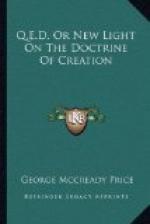As a result of these methods this same author declares: “It is by no means improbable that many of the older genera, now recognized as distinct by reason of our imperfect knowledge concerning their true relationships, have in reality representatives living in the modern seas."[18]
[Footnote 17: “Geographical and Geological Distribution of Animals,” pp. 183, 184.]
[Footnote 18: Id., pp. 207, 208.]
But the situation is very little better when we come to deal with plants and animals of our modern world. Because, with the many thousands of students of natural science all over the world, each anxious to get into print as the discoverer of some new form, the systematists have a dead weight of names on their hands that by a rational and enlightened revision could doubtless be reduced to but a fraction of their present disheartening array. For as the result of the extensive breeding experiments now being carried on under the study of what is called Mendelism (a term that will be explained in the next chapter), it has been found that great numbers of the “species” of the systematists or classificationists will not stand the physiological test of breeding, that is, they are found to breed freely together according to the Mendelian Law. As William Bateson remarks:
“We may even be certain that numbers of excellent species recognized by entomologists or ornithologists, for example, would, if subjected to breeding tests, be immediately proved to be analytical varieties, differing from each other merely in the presence or absence of definite factors."[19]
The following from David Starr Jordan, the leading American authority on fishes, will serve to show how numerous have been the new names invented in recent years, all tending further to confuse and complicate the problem of what is a species:
“In our fresh-water fishes, each species on an average has been described as new from three to four times, on account of minor variations, real or supposed. In Europe, where the fishes have been studied longer and by more different men, upwards of six or eight nominal species have been described for each one that is now considered distinct."[20]
[Footnote 19: “Mendel’s Principles of Heredity,” p. 284, 1909.]
[Footnote 20: “Science Sketches,” p. 99.]
And again:
“Thus the common Channel Catfish of our rivers has been described as a new species not less than twenty-five times, on account of differences real or imaginary, but comparatively trifling in value."[21]
[Footnote 21: “Science Sketches,” p. 96.]
Perhaps the reader will tolerate another somewhat long quotation because of the light which it sheds on this whole problem.




